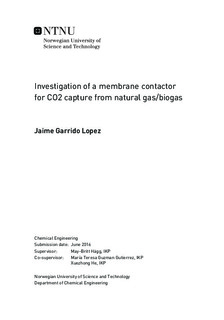Investigation of a membrane contactor for CO2 capture from natural gas/biogas
Master thesis
Permanent lenke
http://hdl.handle.net/11250/2411546Utgivelsesdato
2016Metadata
Vis full innførselSamlinger
Sammendrag
Carbon dioxide needs to be separated from natural gas or biogas streams and membrane contactors can be a very good alternative for it. In this work a poly(1-trimethylsilyl-1-propyne) supported by a polyvinylidene fluoride membrane, also referred as composite PTMSP-PVDF membrane, was studied.
Firstly, a short review of membrane contactors in literature was made, finding out which materials and absorbents are mostly used and understanding which the most important parameters are. Mass transfer theory through a membrane contactor was briefly explained too.
Characterization techniques were used to study the permeability, contact angle and structure. The membrane showed a very high permeability, near to 28000 barrers for CO2, as well as a nice hydrophobicity. However, it showed a not very good stability what should be studied in further works.
The mass transfer in a flat sheet composite PTMSP-PVDF membrane contactor was studied by running different experiments and measuring the CO2 flux as well as the CO2 removal efficiency. The effect of gas flow rate, inlet CO2 concentration, gas pressure, liquid flow rate was studied both for distilled water and NaOH solution as absorbents. The results obtained were discussed to see if it was in agreement with the mass transfer theory and comparing them with literature.
Lastly, the conclusions and future recommendations were postulated. The mass transfer needs to be studied in a well-designed module and at more realistic conditions to ensure that the membrane is appropriate to the process is going to be used. And also, stability of the membrane needs to be improved with, for instance, crosslinking techniques that have shown good results in other works.
